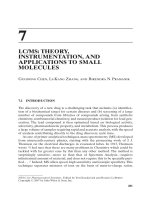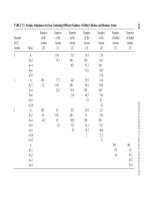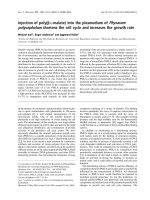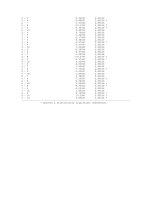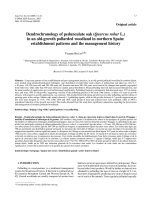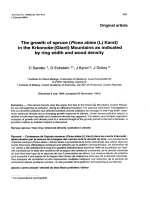Larry l augsburger; stephen w hoag pharmaceutical dosage forms tablets volume 3, manufacture and process control
Bạn đang xem bản rút gọn của tài liệu. Xem và tải ngay bản đầy đủ của tài liệu tại đây (6.81 MB, 321 trang )
Pharmaceutical
Dosage Forms: taBlets
PHARMACEUTICAL
DOSAGE FORMS: TABLETS
Third Edition
Volume 3:
Manufacture and Process Control
Edited by
Larry L. Augsburger
University of Maryland
Baltimore, Maryland, USA
Stephen W. Hoag
University of Maryland
Baltimore, Maryland, USA
CRC Press
Taylor & Francis Group
6000 Broken Sound Parkway NW, Suite 300
Boca Raton, FL 33487-2742
© 2008 by Taylor & Francis Group, LLC
CRC Press is an imprint of Taylor & Francis Group, an Informa business
No claim to original U.S. Government works
Version Date: 20130116
International Standard Book Number-13: 978-1-4200-2030-4 (eBook - PDF)
This book contains information obtained from authentic and highly regarded sources. While all reasonable efforts have
been made to publish reliable data and information, neither the author[s] nor the publisher can accept any legal responsibility or liability for any errors or omissions that may be made. The publishers wish to make clear that any views or
opinions expressed in this book by individual editors, authors or contributors are personal to them and do not necessarily reflect the views/opinions of the publishers. The information or guidance contained in this book is intended for
use by medical, scientific or health-care professionals and is provided strictly as a supplement to the medical or other
professional’s own judgement, their knowledge of the patient’s medical history, relevant manufacturer’s instructions and
the appropriate best practice guidelines. Because of the rapid advances in medical science, any information or advice
on dosages, procedures or diagnoses should be independently verified. The reader is strongly urged to consult the drug
companies’ printed instructions, and their websites, before administering any of the drugs recommended in this book.
This book does not indicate whether a particular treatment is appropriate or suitable for a particular individual. Ultimately it is the sole responsibility of the medical professional to make his or her own professional judgements, so as to
advise and treat patients appropriately. The authors and publishers have also attempted to trace the copyright holders of
all material reproduced in this publication and apologize to copyright holders if permission to publish in this form has
not been obtained. If any copyright material has not been acknowledged please write and let us know so we may rectify
in any future reprint.
Except as permitted under U.S. Copyright Law, no part of this book may be reprinted, reproduced, transmitted, or utilized in any form by any electronic, mechanical, or other means, now known or hereafter invented, including photocopying, microfilming, and recording, or in any information storage or retrieval system, without written permission from the
publishers.
For permission to photocopy or use material electronically from this work, please access www.copyright.com (http://
www.copyright.com/) or contact the Copyright Clearance Center, Inc. (CCC), 222 Rosewood Drive, Danvers, MA 01923,
978-750-8400. CCC is a not-for-profit organization that provides licenses and registration for a variety of users. For
organizations that have been granted a photocopy license by the CCC, a separate system of payment has been arranged.
Trademark Notice: Product or corporate names may be trademarks or registered trademarks, and are used only for
identification and explanation without intent to infringe.
Visit the Taylor & Francis Web site at
and the CRC Press Web site at
To my loving wife Jeannie,
the light and laughter in my life.
—Larry L. Augsburger
To my dear wife Cathy and my children Elena
and Nina and those who helped me
so much with my education:
My parents Jo Hoag and my late father
Jim Hoag, Don Hoag, and Edward G. Rippie.
—Stephen W. Hoag
Foreword
We are delighted to have the privilege of continuing the tradition begun by Herb
Lieberman and Leon Lachman, and later joined by Joseph Schwartz, of providing the
only comprehensive treatment of the design, formulation, manufacture and evaluation of
the tablet dosage form in Pharmaceutical Dosage Forms: Tablets. Today the tablet
continues to be the dosage form of choice. Solid dosage forms constitute about twothirds of all dosage forms, and about half of these are tablets.
Philosophically, we regard the tablet as a drug delivery system. Like any delivery
system, the tablet is more than just a practical way to administer drugs to patients.
Rather, we view the tablet as a system that is designed to meet specific criteria. The most
important design criterion of the tablet is how effectively it gets the drug “delivered” to
the site of action in an active form in sufficient quantity and at the correct rate to meet the
therapeutic objectives (i.e., immediate release or some form of extended or otherwise
modified release). However, the tablet must also meet a number of other design criteria
essential to getting the drug to society and the patient. These include physical and
chemical stability (to assure potency, safety, and consistent drug delivery performance
over the use-life of the product), the ability to be economically mass produced in a
manner that assures the proper amount of drug in each dosage unit and batch produced
(to reduce costs and provide reliable dosing), and, to the extent possible, patient
acceptability (i.e., reasonable size and shape, taste, color, etc. to encourage patient
compliance with the prescribed dosing regimen). Thus, the ultimate goal of drug product
development is to design a system that maximizes the therapeutic potential of the drug
substance and facilitates its access to patients. The fact that the tablet can be uniquely
designed to meet these criteria accounts for its prevalence as the most popular oral solid
dosage form.
Although the majority of tablets are made by compression, intended to be
swallowed whole and designed for immediate release, there are many other tablet forms.
These include, for example, chewable, orally disintegrating, sublingual, effervescent, and
buccal tablets, as well as lozenges or troches. Effervescent tablets are intended to be
taken after first dropping them in water. Some modified release tablets may be designed
to delay release until the tablet has passed the pyloric sphincter (i.e., enteric). Others may
be designed to provide consistent extended or sustained release over an extended period
of time, or for pulsed release, colonic delivery, or to provide a unique release profile for a
specific drug and its therapeutic objective.
Since the last edition of Pharmaceutical Dosage Forms: Tablets in 1990, there have
been numerous developments and enhancements in tablet formulation science and
technology, as well as product regulation. Science and technology developments include
new or updated equipment for manufacture, new excipients, greater understanding of
excipient functionality, nanotechnology, innovations in the design of modified release
v
vi
Foreword
tablets, the use of artificial intelligence in formulation and process development, new
initiatives in real time and on-line process control, and increased use of modeling to
understand and optimize formulation and process parameters. New regulatory initiatives
include the Food and Drug Administration’s SUPAC (scale up and post approval
changes) guidances, its risk-based Pharmaceutical cGMPs for the 21st Century plan, and
its PAT (process analytical technology) guidance. Also significant is the development,
through the International Conference on Harmonization of proposals, for an international
plan for a harmonized quality control system.
Significantly, the development of new regulatory policy and new science and
technology are not mutually exclusive. Rather, they are inextricably linked. The new
regulatory initiatives serve as a stimulus to academia and industry to put formulation
design, development, and manufacture on a more scientific basis which, in turn, makes
possible science-based policies that can provide substantial regulatory relief and greater
flexibility for manufacturers to update and streamline processes for higher efficiency and
productivity. The first SUPAC guidance was issued in 1995 for immediate release oral
solid dosage forms (SUPAC-IR). That guidance was followed in 1997 with SUPAC-MR
which covered scale-up and post approval changes for solid oral modified release dosage
forms. These guidances brought much needed consistency to how the Food and Drug
Administration deals with post approval changes and provided substantial regulatory
relief from unnecessary testing and filing requirements. Major underpinnings of these
two regulatory policies were research programs conducted at the University of Maryland
under a collaborative agreement with the Food and Drug Administration which identified
and linked critical formulation and process variables to bioavailability outcomes in
human subjects. The Food and Drug Administration’s Pharmaceutical cGMPs for the
21st Century plan seeks to merge science-based management with an integrated quality
systems approach and to “create a robust link between process parameters, specifications
and clinical performance”1 The new PAT guidance proposes the use of modern process
analyzers or process analytical chemistry tools to achieve real-time control and quality
assurance during manufacturing.2 The Food and Drug Administration’s draft guidance
on Q8 Pharmaceutical Development3 addresses the suggested contents of the pharmaceutical development section of a regulatory submission in the ICH M4 Common
Technical Document format.
A common thread running through these newer regulatory initiatives is the building
in of product quality and the development of meaningful product specifications based on
a high level of understanding of how formulation and process factors impact product
performance.
Still other developments since 1990 are the advent of the internet as a research and
resource tool and a decline in academic study and teaching in solid dosage forms.
Together, these developments have led to a situation where there is a vast amount of
formulation information widely scattered throughout the literature which is unknown and
difficult for researchers new to the tableting field to organize and use. Therefore, another
objective to this book to integrate a critical, comprehensive summary of this formulation
information with the latest developments in this field.
Thus, the overarching goal of the third edition of Pharmaceutical Dosage Forms:
Tablets is to provide an in-depth treatment of the science and technology of tableting that
1
J. Woodcock, “Quality by Design: A Way Forward,” September 17, 2003.
2
/>
3
/>
Foreword
vii
acknowledges its traditional, historical database but focuses on modern scientific,
technological, and regulatory developments. The common theme of this new edition is
DESIGN. That is, tablets are delivery systems that are engineered to meet specific design
criteria and that product quality must be built in and is also by design.
No effort of this magnitude and scope could have been accomplished without the
commitment of a large number of distinguished experts. We are extremely grateful for
their hard work, dedication and patience in helping us complete this new edition.
Larry L. Augsburger
Stephen W. Hoag
Preface
Volume 3 ties the fundamental process principles and the formulation and excipient
principles presented in the previous two volumes together and applies these principles,
along with additional information, to the commercial production and quality control of
tablets. In particular, scale-up and troubleshooting are covered. Chapters 1–4 address the
equipment, instrumentation for research and process control, automation in tablet
production, and scale-up. In Chapters 5–7, the focus is on postmanufacture testing and
evaluation of tablets, and the setting of dissolution specifications. Chapter 8 discusses the
regulatory and good manufacturing practices environment in which tablets must be
manufactured, with focus on the new paradigms of process analytical technology and
quality by design. This volume concludes with chapters discussing the role of nearinfrared chemical imaging in testing oral solid dosage forms, surface area and important
related physical characteristics of solids, and intellectual property and the patent process.
Larry L. Augsburger
Stephen W. Hoag
ix
Contents
Dedication iii
Foreword v
Preface ix
Contributors xiii
1. Tooling for Pharmaceutical Processing
Dale Natoli
1
2. Tablet Press Instrumentation in the Research and Development Environment
Gary E. Bubb
3. Pharmaceutical Manufacturing: Changes in Paradigms
Jean-Marie Geoffroy and Denise Rivkees
49
85
4. A Forward-Looking Approach to Process Scale-Up for Solid Dose
Manufacturing 119
Fernando J. Muzzio, Marianthi Ierapetritou, Patricia Portillo, Marcos Llusa, Michael
Levin, Kenneth R. Morris, Josephine L. P. Soh, Ryan J. McCann, and Albert Alexander
5. Dissolution and Drug Release Testing
Vivian A. Gray
6. Setting Dissolution Specifications
Patrick J. Marroum
153
191
7. Mechanical Strength of Tablets 207
Go¨ran Alderborn and Go¨ran Frenning
8. cGMPs for the 21st Century and ICH Quality Initiatives 237
Moheb M. Nasr, Donghao (Robert) Lu, and Chi-wan Chen
9. Intellectual Property, Patent, and Patenting Process in the Pharmaceutical
Industry 251
Keith K. H. Chan and Albert W. K. Chan
10. Near-infrared Chemical Imaging for Characterizing Pharmaceutical Dosage Forms 269
Gerald M. Sando, Linda H. Kidder, and E. Neil Lewis
11. Surface Area, Porosity, and Related Physical Characteristics
Paul A. Webb
Index
277
303
xi
Contributors
Go¨ran Alderborn
Department of Pharmacy, Uppsala University, Uppsala, Sweden
Albert Alexander
AstraZeneca, Wilmington, Delaware, U.S.A.
Specialty Measurements Inc., Lebanon, New Jersey, U.S.A.
Gary E. Bubb
University of Maryland, Baltimore, Maryland, U.S.A.
Keith K. H. Chan
Albert W. K. Chan
New York, U.S.A.
Law Offices of Albert Wai-Kit Chan, PLLC, New York,
Chi-wan Chen Office of New Drug Quality Assessment, Center for Drug Evaluation
and Research, U.S. Food and Drug Administration, Silver Spring, Maryland, U.S.A.
Go¨ran Frenning
Department of Pharmacy, Uppsala University, Uppsala, Sweden
Jean-Marie Geoffroy
TAP Pharmaceuticals Inc., Lake Forest, Illinois, U.S.A.
V. A. Gray Consulting, Inc., Hockessin, Delaware, U.S.A.
Vivian A. Gray
Marianthi Ierapetritou Department of Chemical and Biochemical Engineering,
Rutgers University, Piscataway, New Jersey, U.S.A.
Linda H. Kidder
Malvern Instruments, Columbia, Maryland, U.S.A.
Michael Levin Metropolitan Computing Corporation (MCC), East Hanover,
New Jersey, U.S.A.
E. Neil Lewis
Malvern Instruments, Columbia, Maryland, U.S.A.
Marcos Llusa Department of Chemical and Biochemical Engineering, Rutgers
University, Piscataway, New Jersey, U.S.A.
Donghao (Robert) Lu Office of New Drug Quality Assessment, Center for Drug
Evaluation and Research, U.S. Food and Drug Administration, Silver Spring, Maryland,
U.S.A.
Patrick J. Marroum Office of Clinical Pharmacology, Center for Drug Evaluation and
Research, U.S. Food and Drug Administration, Silver Spring, Maryland, U.S.A.
Ryan J. McCann Department of Industrial and Physical Pharmacy, Purdue University,
West Lafayette, Indiana, U.S.A.
Kenneth R. Morris Department of Industrial and Physical Pharmacy, Purdue
University, West Lafayette, Indiana, U.S.A.
xiii
xiv
Contributors
Fernando J. Muzzio Department of Chemical and Biochemical Engineering, Rutgers
University, Piscataway, New Jersey, U.S.A.
Moheb M. Nasr Office of New Drug Quality Assessment, Center for Drug Evaluation
and Research, U.S. Food and Drug Administration, Silver Spring, Maryland, U.S.A.
Dale Natoli
Natoli Engineering Company, St. Charles, Missouri, U.S.A.
Patricia Portillo Department of Chemical and Biochemical Engineering, Rutgers
University, Piscataway, New Jersey, U.S.A.
Pfizer, Inc., Morris Plains, New Jersey, U.S.A.
Denise Rivkees
Gerald M. Sando
Malvern Instruments, Columbia, Maryland, U.S.A.
Josephine L. P. Soh Department of Industrial and Physical Pharmacy, Purdue
University, West Lafayette, Indiana, U.S.A.
Paul A. Webb
Micromeritics Instrument Corp., Norcross, Georgia, U.S.A.
1
Tooling for Pharmaceutical Processing
Dale Natoli
Natoli Engineering Company, St. Charles, Missouri, U.S.A.
INTRODUCTION
Compressing powders into a more solid mass dates back thousands of years. It was not
until the early 1800s that tablet compression was automated in the sense the hand crank
was replaced by a leather belt and a steam driven power bar. These early single station
tablet presses were able to produce on an average 100 tablets per minute while meeting
the guidelines of tablet uniformity for hardness, thickness, and weight. Soon after, single
station presses were fading and making room for new technology, the rotary tablet press.
Introduced in the mid-1800s, the rotary tablet press boasted speeds capable of compressing 1200 tablets per minute. Today, tablet presses are able to compress over 24,000
tablets per minute, and at the rate of new technology, it will surely increase (Fig. 1).
Compressing pharmaceutical tablets is the most efficient process for producing a
single dose of medication. Tablets are accepted and trusted by professionals and consumers alike, they are easily administered and simple to dose.
FIGURE 1 Rotary tablet press cycle.
1
2
Natoli
Good granulation is important for compressing quality tablets. If the granulation is
poor, the long term results will be too. A proper tablet granulation will have good flow,
compressibility, and release properties. Tablet compression tooling is equally responsible
for the success of a tableting program. Tooling must be engineered to withstand the
stresses associated with tablet compression, provide satisfactory service life and maintain
physical tablet uniformity. A proper tablet design is critical as well. Pharmaceutical
marketing departments feverishly attempt to design tablets so unique, anticipating the
design will quickly become branded and trusted in the eye of the consumer. A proper tool
design is essential for putting that innovative design into the eye of the consumer.
The basic knowledge of tablet compression tooling and tablet design can save
literally millions of dollars, prevent product loss, reduce unnecessary equipment downtime and help increase market shares. Understanding the basic physics of tablet compression will greatly enhance the ability to compress quality tablets more efficiently and
provide better knowledge to troubleshoot and identify potential pitfalls before they
happen, and they do!
Communication is important with any tableting campaign. Marketing, R&D,
Engineering, Production, and the tooling supplier must be in accord and communicate
new product-design and production requirements. The ideas and responsibilities of these
departments may vary, but they share the common goal of manufacturing a quality tablet,
efficiently, and productively.
TERMINOLOGY
In order to communicate properly and understand the following material it is important to
have a basic understanding of the terminology used in this industry (Tables 1 and 2).
Although these terms are most common and accepted, some may vary slightly between
countries. This chapter deals with the terminology and general information related to the
most commonly used rotary press tooling, the “TSM,” “B,” “D,” “Euronorm” 19 and
21 mm configurations.
Common Tooling Standards
Internationally there are two recognized standards for tablet compression tooling, the
TSM and the EU standards. Both TSM and EU standards identify the physical tool
configuration for B and D type compression tools, their critical dimensions and associated
tolerances assuring tablet quality and smooth press operation (Figs. 3 and 4).
The TSM tooling standard is recognized in the Americas and is considered
exclusive in the United States. “TSM” is the acronym for the “Tablet Specification Manual”
and is published, revised, and distributed by the American Pharmacist Association in
Washington DC. The TSM Standards, once known as the IPT standards were originally
developed in 1968 by a committee consisting of major pharmaceutical companies in the
United States. The motivation was an attempt to maintain standardization for B and D
tablet compression tooling which provides interchangeability between tablet presses.
The TSM provides engineered drawings that are a valuable reference for troubleshooting
and tool inspection. Today, the TSM committee consists of professionals from the tablet
press, tooling, and tablet manufacturing industries. The TSM also includes useful
information such as standard cup configurations for round tablets and a reference to
common bisects for breaking tablets into multiple uniform dosages.
Punches and Dies Terminology
Term
Tooling set
Tooling station
Head
Head flat
Top head angle
Top head radius
Head back angle
Neck
Barrel or shank
Barrel chamfer
Barrel-to-stem radius
Stem
Tip length
Tip straight
Land
Tip face or cup
Cup depth
Tip relief
Key
Definition
A complete set of punches and dies to accommodate all stations in a tablet press
The upper punch, lower punch, and die which accommodate one station in a tablet press
The largest diameter of a common punch which contacts the machines cams and accepts the pressure from the pressure rollers
The flat portion of the head which makes contact with the pressure rollers and determines the maximum dwell time for compression
Angle from the outside head diameter to the top head radius; it allows for sufficient head thickness and smoother camming
The radius on the top of the head which blends the top head angle to the head flat. Some head configurations may consist of only the head
radius without the head angle. This radius makes the initial contact with the pressure roll and allows a smoother transition into the
compression cycle
Sometimes referred to as the inside head angle, located underneath the top head angle or the top head radius which contacts the machine
camming for vertical movement of the punch within the punch guides
Located below the head and provides clearance as the punch cycles through the machine cams
The vertical bearing surface of a punch which makes contact with the punch guides in the machine turret for verticle guidance
Chamfers at the ends of the punch barrel, eliminate outside corners
The radius that blends the punch barrel to the stem
The area from the barrel to the edge of the punch tip
The straight portion of the punch stem
The section of the tip that extends from the tip relief to the end of the punch tip; it maintains the punch tip size tolerance
The area between the edge of the punch cup and the outside diameter of the punch tip; this adds strength to the tip to reduce punch tip
fracturing
The portion of the punch tip that determines the contour of the tablet face; it includes the tablet embossing
The depth of the cup from the highest point of the tip edge to the lowest point of the cavity
The portion of the punch stem which is a undercut or made smaller than the punch tip straight; most common for lower punches to aid in
reducing friction from the punch tip and die wall as the punch travels through the compression cycle; the area where the punch tip and
relief meet must be sharp to scrape product from the die wall as the lower punch travels down for the fill cycle
A projection normally of mild steel which protrudes above the surface of the punch barrel. It maintains alignment of the upper punch for
reentry into the die; mandatory on upper punches with multiple tips and all tablet shapes other than round; commonly used with
embossed round tablet shapes when rotation of the punch causes a condition known as double impression
Tooling for Pharmaceutical Processing
TABLE 1
(Continued )
3
4
TABLE 1
Punches and Dies Terminology (Continued )
Term
Key position
Punch overall length
Working length
Anneal
Bakelite tip relief
Barrel Flutes
Die
Die height or overall
length
Die outside diameter
Die bore
Die groove
Die lock
Die chamfer
Die taper
Definition
The radial and height position of a key on the punch barrel; not found in all presses
The total length of a punch, other than flat-face tablet configurations, that is normally a reference dimension which consist of a
combination of the working length and the cup depth dimensions
The dimension from the head flat to the lowest measurable point of the tip face, responsible for the consistency of the tablet overall
thickness
A heat-treating process used on fragile punch tips to decrease the hardness of the punch cups reducing punch tip fracturing
An undercut groove between the lower punch tip straight and the relief; it assures a sharp corner to assist in scraping product adhering to
the die wall: normally a purchased option for lower punches
Verticle slots machined into the punch barrel to reduce the bearing surface and assist in removing product in the punch guides: a purchased
option for upper and lower punches
A component used in conjunction with the upper and lower punches; it accepts the product for compaction and is responsible for the
tablet’s perimeter size and configuration
The entire height or overall length of a die
The largest diameter of a die, commonly referred to as the die O.D.
The cavity of a die that accepts the product for compaction and determines the tablets size and shape configuration
The radial groove around the die O.D. which accepts the die lock to secure the die in position in the die table
The mechanism used to lock a die in position after it is installed in the die table
The angled area between the top of the die and the die bore; it assists in guiding. the upper punch into the die bore
A gradual increase in dimension, starting from a given depth in the die bore and increasing to the die chamfer; used normally to release air
from the die cavity during the compression cycle
Natoli
Tooling for Pharmaceutical Processing
TABLE 2
Tablet Terminology
Term
Major axis
Minor axis
End radius
Side-radius
Band
Compound cup
Embossed
Debossed
5
Definition
The largest dimension of a shaped tablet
The smallest dimension of a shaped tablet
The radius on either end of a capsule or oval-shaped tablet
The radius on either side of an oval or modified shaped tablet
The center section of a tablet between the cup profiles: it is governed by a direct
relationship of the die cavity profile.
A cup profile which consist of two or more radii
The raised identification on a tablet or a punch face; an embossed punch tip
results in a debossed tablet.
The depressed identification on a tablet or a punch face: a dehossed punch tip
results in a embossed tablet
FIGURE 2 Tool drawing.
6
Natoli
FIGURE 2A Tablet drawing.
Tooling for Pharmaceutical Processing
7
The EU tooling standard is internationally recognized and is more widely used than
its counterpart, the TSM standard. EU which is the acronym for “Eurostandard” and
“Euronorm” is considered the European standard for interchangeable B and D type
compression tools. The EU standards are authored by Mr. Trevor Higgins with the
attempt to establish a tooling “norm” that provides tool interchangeability with the most
common B and D type European tablet presses. The EU standard is printed and distributed by I Holland Ltd, Nottingham, England.
EU, TSM, B AND D TYPE PUNCHES
The TSM and EU standards manuals provide mechanical drawings and technical information for B and D type tools which constitutes a majority of the tool configurations used
today. The B type configuration has a nominal punch barrel diameter of 0.750 in./19 mm.
The B type has two different die sizes. The larger B dies have a diameter of 1.1875 in.
(30.16 mm) and the smaller BB dies have a 0.945 in. (24 mm) diameter. The D type has a
larger nominal barrel diameter of 1 in. (25.4 mm) and a die diameter of 1.500 in.
(38.10 mm.) The B and D tool designation identifies the physical tooling size and was
coined by Engineer Frank J. Stokes in the late 1800s.
Mr. Stokes resided in Philadelphia, Pennsylvania when he developed the first
commercially available rotary tablet in the United States, the Stokes B1 Rotary. The B1
rotary press was extremely successful and most wanted by pharmaceutical companies
nationwide. Mr. Stokes, realizing the need for compressing larger and heavier tablets,
developed the Stokes D3 rotary tablet press. The D3 tablet press uses slightly larger
punches and dies, increasing the overall capacity to compress larger and heavier tablets.
During the second industrial revolution, Mr. Stokes expanded manufacturing
capabilities and operated a facility in England for international distribution. Stokes soon
became the world’s leading tablet press manufacture and sold tablet presses and tooling
in nearly every industrialized country. The designation B and D quickly became the
international standard for identifying a tablet press capacity and a tool configuration, as it
still is today.
At the brink of World War II, Stokes left England and focused all manufacturing
activities in Pennsylvania. Stokes left behind trained engineers and qualified manufacturing personnel who soon realized the potential of the tablet press market and began
manufacturing tablet presses and tooling under the name Manesty. As a marketing
strategy, Manesty re-engineered the punches and tablet press cams to enhance tooling life
and provide better performance. The Manesty punch is similar to the original Stokes
design, but is exclusive to Manesty presses and not interchangeable with the more
popular Stokes tablet presses. Manesty called their tablet presses the “Manesty B3B” and
the larger “Manesty D3a.”
Manesty soon became a major supplier in the compression equipment industry and
successfully competed against Stokes in the global market. In the mid-1980s the tablet
press industry exploded and press manufactures were competing with tablet press output
and innovation. Accommodating newer and high-speed tablet presses, the original
Manesty tooling standard was refined to provide better interchangeability with the most
common B and D tablet presses, identified by the “Eurostandard,” often referred to as the
EU standard and the EU norm (Fig. 3).
There are various models of tablet presses that do not conform to the standard B
and D tool configurations and are engineered to be exclusive to a particular make and
model of tablet press. Some of the more common configurations were designed in the
8
Natoli
FIGURE 3 Drawing showing the differences between the B and D TSM and EU configurations.
early 1900s and still used on tablet presses today. These unique tablet presses are
generally larger and engineered to compress larger tablets more effectively. Kilian Gmbh,
a division of IMA in Milan, Italy, is a major European manufacturer of tablet presses
using the most common unique tool configuration. The Kilian style upper punch does not
use the common punch head configuration to guide the punches through the press cams;
instead, the upper punch is guided by a machined cam angle located on the side of the
upper barrel. The Kilian design provides a larger head flat, therefore, increasing the
compression dwell time over the more popular B and D type tools (Fig. 5).
RECENT INNOVATIONS
New technology continues to introduce innovative tool configurations in the effort to
provide better efficiency of tablet press speed, product yield, cleaning, and safety.
In 1997, Ima introduced a line of unique tablet presses called the Ima Comprima.
The Ima Comprima models use an innovative approach with tool design and granulation
Tooling for Pharmaceutical Processing
9
FIGURE 4 Drawing showing the differences between the B and D TSM and EU configurations.
FIGURE 5
Drawing Kilian 27/32.
